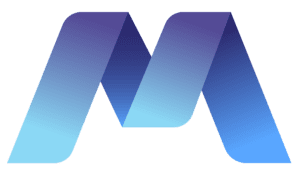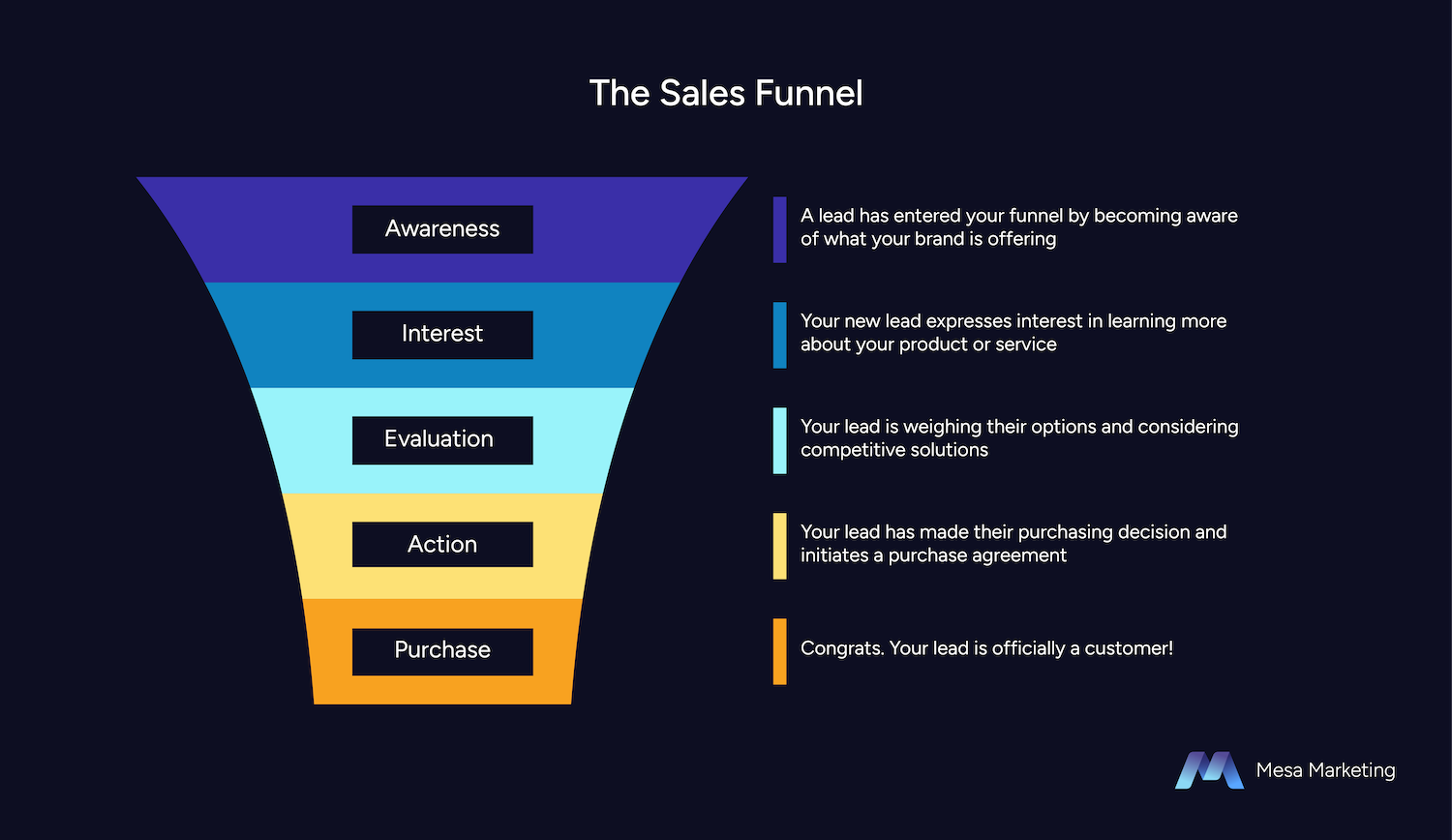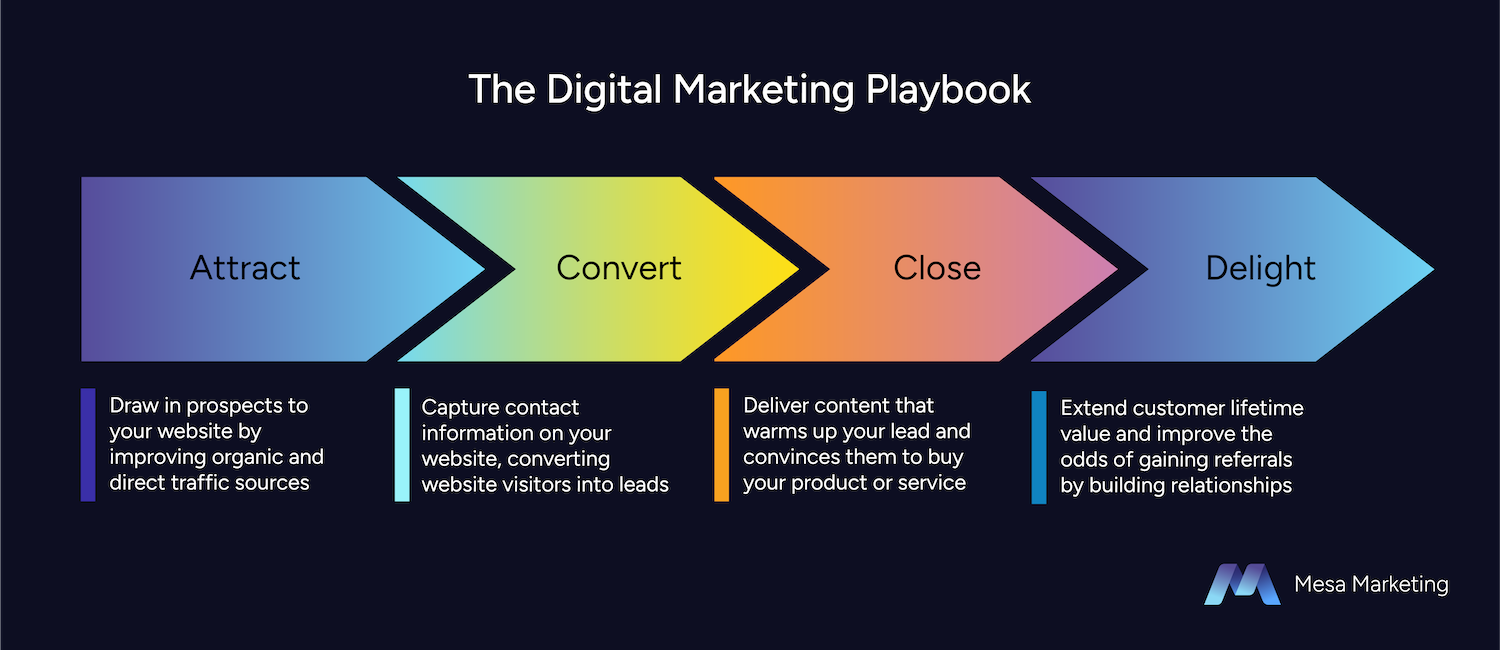Guide to Growing Your Sales Funnel + 30 Must-Have Tools for Lead Generation
Expand your sales pipeline with these high-powered tools for lead generation that attract, convert, and cultivate leads
Date: 01/09/23 | Author: Whitney Slightham
Lead generation is one of the most important marketing goals to focus on. Yet many marketers find it challenging to develop a fine-tuned strategy that reliably attracts and converts leads, and moves leads through the sales funnel. In this guide, we’ll explore sales funnel basics, customer research, effective content types for each stage of the funnel, and tools for lead generation.
Table of Contents:
- Defining Your Target Audience
- Buyer Persona Research 101
- How To Conduct Buyer Persona Interviews
- Understanding The Buyer’s Journey
- What Is A Sales Funnel?
- Lead Qualification
- The Digital Marketing Playbook
- Measuring Predictive Revenue Growth
- How to Craft Great Content for Each Stage of the Funnel
- Must-Have Tools for Lead Generation
Defining Your Target Audience
Before we jump into sales and lead generation strategies and tools, let’s talk about your buyers for a minute. Without understanding your buyers and their needs, it’s impossible to build an optimized marketing and sales strategy. In the past decade, buyer persona research has become a staple in both inbound and outbound marketing strategies.
Buyer Persona Research 101
Buyer personas are semi-fictional representations of your ideal customer segments. These personas depict key characteristics that define each audience segment. And I’m not just talking about basic demographics – we’re aiming to categorize a set of common psychological traits as well. How likely are they to be influenced by peers? How do they approach purchasing decisions? Do they prefer to research products independently, or do they want to engage with a sales representative?
Unlike other forms of consumer research that bundle buyers together based on their age, job title, interests, or location, buyer persona research drives immense value to sales teams because it pushes the customer’s journey to the forefront.
Now, you may be wondering where to start with buyer persona research.
If you’re a marketer looking to deepen your market research knowledge, I highly recommend Buyer Personas by Adela Revella. I read this book back in 2015 and still draw on many of the methodologies today.
Here’s the TL;DR version of the book and Revella’s research strategy.
First, there are five rings of buying insights:
- Priority Initiatives: What is your buyer’s pain point that they need to overcome?
- Success Factors: How does your customer envision success after overcoming their challenge?
- Decision-Making Criteria: Which product features and benefits are most important to your buyer?
- Perceived Barriers: Did they experience any roadblocks along their purchasing journey? Was there anything negative about their experience?
- Buyer’s Journey: How did they navigate the purchasing process, from the moment they identified their need to when they bought your product or service?
How To Conduct Buyer Persona Interviews
To uncover these insights, set up one-on-one interviews with current or past customers who depict a key sales segment that you want to continue luring in. During the interviews, it’s important not to lead the customer. Ask them structured questions, and listen, record, and transcribe the interviews. While reviewing the transcriptions, highlight and code phrases that reflect each of the buying insights. For example, if they talk about pricing or key features they like, pull out those quotes for your “Decision-Making Criteria” bucket. After reviewing qualitative data from several transcripts, you may see certain patterns emerging. These patterns will help you define a target buyer audience based on their goals, definition of success, desired features and benefits, objections, and purchasing process.
While you have your customers engaged in an interview, why not also throw in some website user experience (UX) testing? This way you can see firsthand how your buyers consume and navigate your brand’s digital content, and make content tweaks accordingly.
The Key To Building A Sales Funnel: Understanding the Buyer’s Journey
Each of the rings of buying insights provides a basis for strong messaging, market positioning, and UX design. But arguably the most important ring of insight for building a sales funnel is understanding the buyer’s journey.
Whereas sales funnels reflect a prospective buyer’s experience from the seller’s point of view, the buyer’s journey considers how the buyer experiences the sales process.
There are three key stages of the buyer’s journey:
- Awareness Phase: During this stage, your buyer notices they have a problem, and they want to resolve it.
- Consideration Phase: By now, your buyer has a better understanding of their problem, and how to resolve it, and they’re starting to investigate products or services that can help them.
- Decision Phase: Your buyer has narrowed down a few options, and is ready to buy. Keep in mind that your buyer may not be the only one influencing the purchasing decision. Big-ticket item B2B sales, in particular, often require buy-in from multiple professionals within your buyer’s organization – each lending unique perspectives, needs, and objections. In these cases, I usually try to conduct interviews with each of the main stakeholders involved in purchasing my client’s product or service.
Understanding your buyer’s journey allows you to deliver engaging content that targets prospects at appropriate stages. We’ll dig deeper into how to create content for each stage of the funnel soon.
What Is A Sales Funnel?
Sales funnel, marketing funnel, revenue funnel: they all depict the natural prospect attrition that occurs during the sales process. Sales funnels typically start out with a large number of prospects who enter the funnel by engaging with your brand. But not all prospects who enter your funnel are bonafide, qualified leads, and even fewer will become real customers.
There are five key components of the sales funnel:
- Awareness: A lead has entered your funnel by becoming aware of what your brand is offering. You know that they’ve entered the funnel because they’ve exchanged their contact information for something they value, like an ebook download or a webinar appointment.
- Interest: Your new lead expresses interest in learning more about your product or service, and begins engaging with your sales team or content.
- Evaluation: Your lead is weighing their options and considering competitive solutions.
- Action: Your lead has made their purchasing decision and is initiating a purchase agreement.
- Purchase: Your lead is officially a customer!
Remember: the sales funnel is more than just a chart. It’s an important sales strategy used to drum up new leads and methodically handle lead engagement. Sales funnels also help sales teams segment and focus on a specific group of qualified leads. This prevents wasting sales resources by engaging with prospects who aren’t the right fit in the first place.
Lead Qualification
There are three types of qualified leads:
- Information Qualified Leads (IQL): Also called cold leads, IQLs have recently entered the funnel by exchanging their contact information for something they value.
- Marketing Qualified Leads (MQL): MQLs show interest in the business and continue to engage with your brand’s middle-of-funnel content.
- Sales Qualified Leads (SQL): Sales teams usually qualify leads once they are ready to make a purchase in the Action and Purchase stages of the funnel.
The Digital Marketing Playbook
Alright, here’s one more framework to toss into the mix, and then we can move on to my favorite tools for lead generation. Popularized largely by HubSpot over the past decade, the Inbound Marketing Process involves four phases:
- Attract: Draw in prospects to your website by improving organic and direct traffic sources.
- Convert: Capture contact information on your website, converting website visitors into leads.
- Close: Deliver content that warms up your lead and ultimately convinces them to buy your product or service.
- Delight: Build long-lasting relationships with your customers to extend lifetime value and improve the odds of gaining referrals.
If you want to learn more about inbound marketing basics, I highly recommend HubSpot’s free certification.
The Buyer’s Journey, Sales Funnel, and Inbound Marketing Process each follow the same pattern of luring in strangers, converting them into connections, and then selling them something.
But the Inbound Marketing Process takes one extra step by including the “delight” phase. During this phase, marketers and sales teams focus on building long-lasting relationships with their existing customers. Building out a solid customer retention strategy by investing in tactics that delight keeps customers happy and helps secure future revenue growth.
Measuring Predictive Revenue Growth
Net Promoter Score
Many marketers use the net promoter score (NPS) to gauge customer satisfaction. The net promoter score formula is easy to calculate. Ask your customers on a scale of 1 – 10 how likely they are to recommend your brand to a friend or colleague. If they give you a 1 – 6, then they’re a detractor and are likely to negatively talk about their experience with your product or service. A 7 – 8 score is passive, which means they will neither negatively nor positively influence referrals. What you’re looking for is a 9 or 10 score. These customers are your brand ambassadors who will help drive referrals and future revenue growth. To calculate your total net promoter score, subtract the percentage of detractors from the percentage of promoters.
Lead-to-Revenue Management Metrics
Other ways to measure predictive sales revenue include:
- Conversion rate: The percentage of leads who become customers. (And the percentage of website visitors who convert into leads, though it’s less predictive of revenue growth).
- Cost per conversion: Divide your total marketing costs by the number of conversions your strategy yields.
- Customer lifetime value: How much money is each customer predicted to spend over the customer relationship? Calculate the customer lifetime value by multiplying the average customer retention time by the average total order amount, multiplied by the average number of orders.
- Entrances: How many leads come into the funnel within a period of time?
- Flow rate: How long leads spend in each stage of the funnel.
- Win Rate: The win rate is a percentage reflecting the number of deals closed divided by the total number of qualified leads in your sales funnel, multiplied by 100.
How to Craft Great Content for Each Stage of the Funnel
Once a prospect enters the funnel, we want to keep moving them through. Marketers can help drive revenue growth by delivering appropriate content to leads based on their funnel position. Marketers typically break up sales funnel content into three categories:
Top-of-Funnel Content
The key here is to build content that positions your brand as a trusted authority on topics that your leads are interested in. During this stage, your buyer notices they have a problem and want to resolve it. As marketers, we want to educate top-of-funnel leads about their options without being too pushy. Top-of-funnel content is relevant to your target buyer persona and is typically oriented around keywords and phrases that your targets are likely to query.
Top-of-funnel marketing content includes:
- Tutorials
- How-To Guides
- Helpful articles
- SEO
- PPC
- Influencer content
- Social publishing
- Podcasts
- Press releases
- Contests
- Product ads
Middle-of-Funnel Content
As soon as your customer converts, start engaging with them. This is where automated emails and drip campaigns come in handy, to reduce direct sales outreach needs. At this stage, your lead is researching their options. Deliver middle-of-funnel leads with content that educates and engages them about both the problem they want to overcome and your brand’s specific solution. Middle-of-funnel content is meant to be more direct so leads are pushed through the funnel.
Middle-of-funnel marketing content includes:
- Webinars
- Buyer guides
- Case studies
- Explainer videos
- FAQs
- Newsletters
- Testimonials
- Reviews
- Product/service rankings (external websites)
- Email drip campaigns
Bottom-of-Funnel Content
Now that you’ve warmed up and qualified your lead, it’s time to really differentiate your offering. Bottom-of-funnel content should be saturated with powerful feature lists, benefit statements, and unique value proposition messaging. As a marketer, your goal here is to cut straight to the chase and try to support sales in closing the deal.
Bottom-of-funnel marketing content includes:
- Demos
- Case studies
- Reviews
- White papers
- Discounts
- Cut sheets
- Pitch decks
- Product pages
- Pricing page
- Comparison tools
- Sales calls
Must-Have Tactics and Tools for Lead Generation
Now that we’ve covered the basics, here are my favorite tools for lead generation and cultivation. Use these tools along with top- and middle-of-funnel content to attract and warm up leads.
Top-of-Funnel Tools for Lead Generation to Attract Prospects
Search Marketing Tools
- Ahrefs: A supercharged database used for keyword research, link building, and web search analysis. Ahrefs offers free SEO tools and paid subscriptions. It’s pricey, but worth the investment if you’re serious about taking your SEO marketing strategy to the next level.
- Ubersuggest: Ubersuggest is a popular keyword research and web auditing tool. Try downloading the free Ubersuggest chrome extension for monthly search volume insights.
- Semrush: Similar to Ahrefs, Semrush is a high-powered search marketing database that helps marketers plan content and optimize their sites for search.
- Google Business Profile: This free tool allows organizations to show up in local Google search results and maps.
- Google AdWords: Use Google AdWords to target specific audiences with pay-per-click ads that position your website at the top of Google search results pages.
- Google Local Service Ads: Similar to AdWords, Local Service Ads displays targeted ads to prospects based on your business’s location. This is one of my favorite paid advertising tools for businesses that want to attract customers in their area.
Influencer Marketing
- Upfluence: Upfluence helps you identify influencers, affiliates, and ambassadors to generate content and leads on behalf of your brand.
- LTK: A leader in retail influence network programs, LTK helps connect brands with creators.
- BuzzSumo: Helps you identify influencers and journalists to help you pitch products and services.
Website Optimization
- Google Analytics: This powerful tool helps you measure website and digital advertising performance.
- Crazy Egg: Learn how users actually navigate your website with this heat mapping software.
- Yoast: This popular tool – and free WordPress plugin – offers immediate content analysis to help you optimize your page around specific keywords and phrases.
Referral Campaign Software
- Referral Factory: Build landing pages to engage existing customers and issue unique links to referrers. This tool allows you to keep track of your referral network and issued rewards.
Positive Review Campaign Tools
- EmbedReviews: Embed reviews from across platforms onto your website to show off your positive reviews.
- NiceJob: Easily invite customers to leave you a review via text or email with NiceJob.
Direct Outreach Tools
- LinkedIn Sales Navigator: LinkedIn Sales Navigator helps you search profiles and find prospects to build relationships with.
- Apollo.io: Access thousands of prospect profiles in your field with Apollo.
Media Relations Software
- Cision: I’ve been using Cision for 12 years and it just keeps getting better and better. If you work in PR or media relations, Cision is a must-have tool for building media lists and pitching stories.
Social Media Management
- Hootsuite: Quickly schedule and publish content across social media platforms.
- Brandwatch (Formerly Falcon.io): This is a terrific social listening tool.
- Canva: Don’t have Adobe or a graphic designer on staff? Make high-quality social media videos, ads, and posts with Canva’s free design platform.
Middle-of-Funnel Tools for Lead Generation to Convert Leads
Webinar Software
- Zoom: Zoom webinars are an easy way to host webinars and track participation.
- Livestorm: Host virtual meetings and webinars on Livestorm’s cloud-based platform.
Customer Relationship Management Software
- Agile CRM: A powerful all-in-one platform, Agile CRM allows you to manage leads and track engagement, perform outbound calls and emails, create landing pages, live chat, and develop drip campaigns.
Email Marketing Software
- MailChimp: MailChimp allows you to segment and manage your lists, send attractive emails, build out automations, and generate leads with online forms. Another plus? It’s one of the most affordable email marketing solutions out there.
- Flodesk: Flodesk boasts an easy-to-use platform for building fresh and modern email campaigns.
Live Chat
- LiveChat: LiveChat is a highly-rated and popular live chat tool with hundreds of integrations with customer relationship management, e-commerce, and email marketing platforms.
- HubSpot or Agile CRM Chat: I like either of these chat tools because they’re already embedded with popular customer relationship management tools, which means you won’t need to maintain prospect data in two separate systems.
Landing Page Software
- Unbounce: Quickly build effective landing pages with Unbounce’s AI-assisted webpage design platform. Unbounce allows you to generate content that targets specific audiences, automatically adapting the UX based on who is looking at your website.
- WordPress: You don’t need fancy landing page software to make a great, targeted landing page for your website – especially if you understand the buyer’s journey. At Mesa, I exclusively use the WordPress content management system to build out content that attracts and converts leads.
Let us help you boost lead generation with user-focused web design, content strategy, and search marketing.
At Mesa, we’re experienced, versatile, and have a proven track record of creating powerful websites that:
Author Profile: Whitney Slightham has custom-developed WordPress websites and led strategic communications initiatives for 13 years. Her digital marketing and public relations campaigns have earned 11 national and international recognitions. Slightham has a proven track record of driving revenue and elevating technical stories in prime media markets. Raised in Toronto, Canada, she now lives in Flagstaff, Arizona with her husband, son, and husky.








